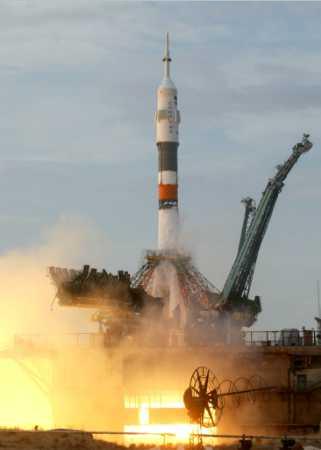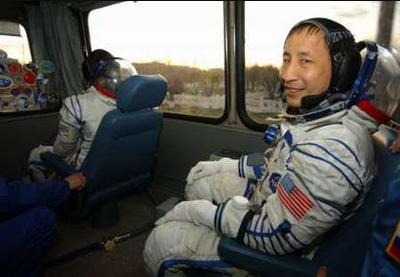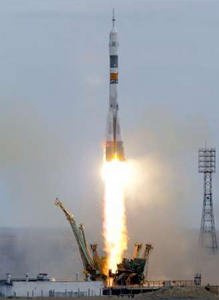First Mission To Space Since Columbia
It's not going to be an easy mission. Two astronauts instead of
three. Six months living in confined quarters with no one else
around. And it got underway today as a Soyuz TMA-2 spacecraft
thundered skyward from the Baikonur Cosmodrome in Kazahkstan.

No Third Crewman
NASA's Dr. Ed Lu and Russian Col. Yuri Malenchenko lifted off
from Baikonur on schedule Saturday morning, on a mission vital to
the very survival of the International Space Station. Their science
missions have been drastically pared down, along with the crew.
ISS-7 is now a mission to keep the station operative and in good
repair - mainly, a maintenance mission.
Russian Cosmonaut Alexander Kaleri was supposed to have been
part of this crew. But, after the American space shuttle fleet was
grounded in the wake of February's Columbia disaster, Kaleri gave
up his seat so it could be filled with supplies. Both the Russian
space agency and NASA say a two man crew will be much easier to
maintain and resupply during this extended mission.

Perfect Launch
"It's a kind of mix of joy, relief and sheer pride," said Lu's
fiancee, Christine Romero, after watching the launch. "After the
(Columbia) tragedy we've endured, we just feel so proud to be part
of this. We are riding on their coattails." While Ms. Romero and
Lu's brother watched the launch, none of Malenchenko's friends or
relatives attended. In the Russian space program, it's considered
bad luck for them to attend a lift-off.
The 130-foot Russian rocket, topped by a space capsule built
along the same lines as that which took the first man to space,
Yuri Gregarian in 1961, blasted off from the Cosmodrome's Launch
Pad One Saturday morning. Nine minutes later, Malenchenko and Lu
were in orbit.
Russian flight director Vladimir Solovyov said after the
lift-off, "They flew up normally. The parameters of the orbit are
perfectly normal. The cosmonauts are feeling well."
See Ya Monday!
 It will take the crew of ISS-7 two days to
rendesvous with the ISS. They'll spend a week on board with the
crew of ISS-6 - Americans Kenneth Bowersox and Donald Pettit and
cosmonaut Nikolai Budarin, who have been in space since November.
They were supposed to have come home last month, but the Columbia
disintegration delayed their return until sometime early next
month.
It will take the crew of ISS-7 two days to
rendesvous with the ISS. They'll spend a week on board with the
crew of ISS-6 - Americans Kenneth Bowersox and Donald Pettit and
cosmonaut Nikolai Budarin, who have been in space since November.
They were supposed to have come home last month, but the Columbia
disintegration delayed their return until sometime early next
month.
ISS-7 marks a true revolution in the international effort to
maintain a human presence in Earth orbit. The crew was supposed to
have flown to the station aboard the space shuttle Atlantis. But
because of the Columbia tragedy, the Russians stepped up to the
plate, offering the Soyuz spacecraft as a launch and recovery
vehicle, and promising to keep the ISS supplied until the American
space fleet is flying again, perhaps by the end of the year. After
a year marked by disagreements between the two countries over the
war in Iraq, officials at both countries' space agencies said the
new spirit of cooperation will go a long way.
"Basically it came to this: Right now, there is only one ship
that can take a crew to the International Space Station. Russia has
to do it," said Sergei Gorbunov, spokesman for Rosaviakosmos, the
Russian space agency.
At Russian Mission Control, Joel Montalbano, an ISS flight
director for NASA, said Saturday's flight was "a tribute to the
robustness of the ISS partnership."
"On a day like this, you see the commitment of the international
community to pursuing space travel," said NASA deputy director
Frederick Gregory at the Baikonur Cosmodrome.
 ANN's Daily Aero-Term (12.08.25): Decision Altitude (DA)
ANN's Daily Aero-Term (12.08.25): Decision Altitude (DA) ANN's Daily Aero-Linx (12.08.25)
ANN's Daily Aero-Linx (12.08.25) NTSB Final Report: Piper PA-31T3
NTSB Final Report: Piper PA-31T3 Aero-News: Quote of the Day (12.08.25)
Aero-News: Quote of the Day (12.08.25) Airborne-Flight Training 12.04.25: Ldg Fee Danger, Av Mental Health, PC-7 MKX
Airborne-Flight Training 12.04.25: Ldg Fee Danger, Av Mental Health, PC-7 MKX





